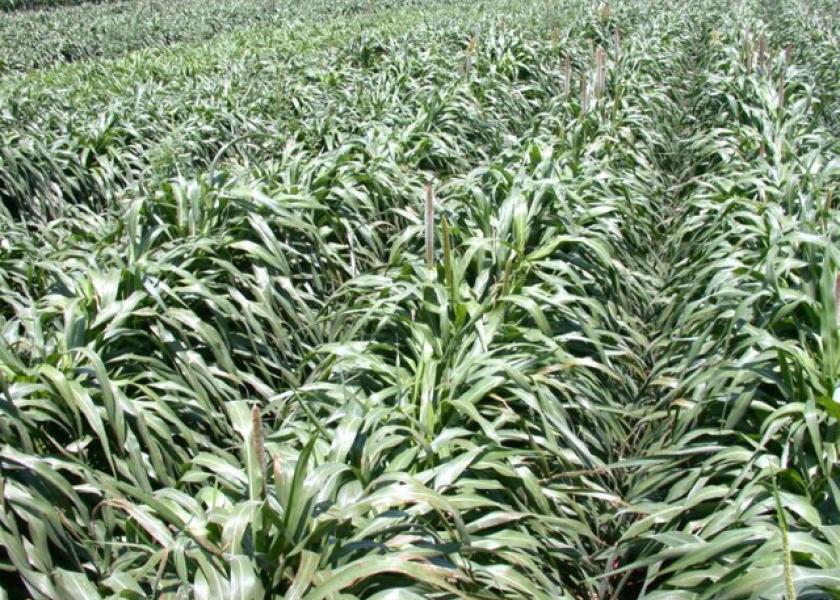Hybrid Pearl Millet may Resolve some Forage Sorghum Concerns

Hybrid pearl millet may be a suitable replacement for forage sorghums susceptible to sugarcane aphid, according to Texas A&M AgriLife Extension experts.
By: Kay Ledbetter, Texas A&M AgriLife Extension
With the widespread presence of sugarcane aphid in Texas in 2014, and an expectation this pest could be a threat in 2015 to Texas sorghums, Texas A&M AgriLife Extension Service experts said hybrid pearl millet might be an alternative for growers.
“This is true especially for growers who need annual forage and grazing, as the hybrid pearl millet appears to be largely unaffected by sugarcane aphid,” said Calvin Trostle, AgriLife Extension agronomist in Lubbock.
This leafy forage may fit where some sorghum forages, in particular sorghum/sudan or haygrazer – a common annual choice for grazing and haying, suffered a heavy hit by sugarcane aphid in 2014, Trostle said.
As of early 2015, he said, there are no commercial forages like sorghum/sudan, sudangrass, sorgo/sudan or haygrazer that have been publicly identified as tolerant to sugarcane aphid.
“This might change if forage lines that produce well in the presence of sugarcane aphid are identified,” Trostle said.
The sugarcane aphid reproduces very fast, doubling in as little as five days when conditions are favorable, and can devastate a forage or grain crop of sorghum in a few weeks, said Dr. Allen Knutson, AgriLife Extension entomologist in Dallas.
The AgriLife Extension specialists said sorghum forages infested by sugarcane aphids and the honeydew excreted by the insects are not harmful to livestock. However, a black sooty mold can grow on the honeydew deposits and the black mold may contribute to reduced palatability of the forage.
There are two insecticides specifically labeled for sugarcane aphid control in sorghum forages: Transform by Dow AgroSciences and Sivant by Bayer CropScience, Knutson said. However, treatment thresholds for labeled rates of both insecticide have a seven-day restriction on haying or grazing after application, which requires moving any cattle from the field, he said.
Forage growers may be reluctant to apply an insecticide for sugarcane aphid due to the cost of the application relative to crop value, and they may not be equipped to spray for the insect, said Dr. Vanessa Corriher-Olson, AgriLife Extension forage specialist in Overton.
Also, control of sugarcane aphid with insecticides requires good coverage throughout the entire canopy, including lower leaves, which is difficult to achieve in forage sorghum due to the dense canopy, Corriher-Olson said.
For these reasons, early harvest or flash grazing of sorghums may be the best option if the insect numbers and leaf damage are increasing in sorghum family forages, she said.
Knutson said the sugarcane aphid infestations will likely persist in sorghum fields following grazing or harvest and increase on young, tender forage regrowth. If a second cutting is desired, the field should be scouted once a week to determine if the infestation threatens the crop.
After observations in several Texas areas in 2014 by producers, AgriLife Extension agents, millet breeders and entomologists, sugarcane aphid was not found in hybrid pearl millet, Trostle said.
“This does not mean that sugarcane aphid can’t be found in millets, but it appears these aphids find the hybrid pearl millet an unsatisfactory host, and they do not significantly increase their numbers nor is damage expected while they are on it,” he said.
Though further field observations are needed, testing of sugarcane aphid preference on numerous forages other than sorghum, including hybrid pearl millet, was conducted by Dr. Scott Armstrong, U.S. Department of Agriculture-Agriculture Research Service entomologist, Stillwater, Oklahoma.
Based on his data as well 2014 field observations in Texas, when sugarcane aphids were common and damaging nearby sorghum forages as well as Johnsongrass, Armstrong concluded the hybrid pearl millet is a poor host to the sugarcane aphid.
Trostle said Armstrong further stated that if the insects were present, the populations would only increase slowly, allowing time for beneficial insects to also reduce the sugarcane aphid numbers.
“Growers in Central and South Texas, where hybrid pearl millet is rarely used, may find in 2015 that planting a portion of their acreage may be a possible approach, at least until sugarcane aphid-resistant sorghums are available,” he said.
Factors influencing that decision will include the agronomics, the potential adaptation to farm and the risk that sugarcane aphid may present to essential forage production from sorghums, Trostle said.
For further information on hybrid pearl millet’s forage characteristics and production agronomics, consult millet crop information athttp://publications.tamu.edu/#forage. This millet’s management reflects small seed size, tolerance of iron deficiency and high pH soils, and it does not develop prussic acid potential.
“If you are concerned about sugarcane aphid, you may consider planting a bag of different pearl millet hybrids and try them on your farm,” he said. “At a minimum, if sugarcane aphid becomes prevalent and widely damaging, you will have some forage that should be safe from the level of damage seen in sorghums.”
Also, Trostle said, “If you lose some sorghum forage earlier in the season, you might consider replanting some millet later in the season, perhaps even into July.”
To track current Texas information on sugarcane aphid activity, go to http://txscan.blogspot.com/. This link also includes current-year sugarcane aphid distribution maps as well as sugarcane aphid resources including control measures.
Forage growers can also find sugarcane aphid management and control strategies listed in “The sugarcane aphid: A new pest of grain and forage sorghum,” http://lubbock.tamu.edu/files/2015/05/SCA-Management-Guide.pdf.







